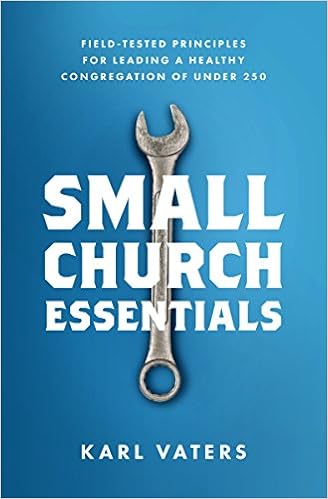 I’ve stopped going to almost every conference. When I get fliers in the mail I usually throw them away. I’ll freely confess I’m likely throwing the baby out with the bathwater here, but I simply got tired of shelling out $200 or more only to be told all the things our little church was doing wrong and how if we put into practice these principles from a mega-church or gave money to this celebrity preacher he could show us how to fix everything.
I’ve stopped going to almost every conference. When I get fliers in the mail I usually throw them away. I’ll freely confess I’m likely throwing the baby out with the bathwater here, but I simply got tired of shelling out $200 or more only to be told all the things our little church was doing wrong and how if we put into practice these principles from a mega-church or gave money to this celebrity preacher he could show us how to fix everything.
I’ve grown weary of that shtick. And my weariness extends beyond conferences to books as well. So, I’ll be honest and say I’m a bit surprised I even purchased Small Church Essentials by Karl Vaters. But as I flipped through the pages in my local Christian bookstore I discovered enough in there which made me shell out the $10 and give the book a go.
What I’m looking for is a book written from the perspective of a small church guy who knows how we function. I’m not looking for the perspective of a mega-church guy who was once a small church guy but has now entered the promised land of a big booming church and can give us the road map to get there ourselves. Don’t get me wrong, I’d be overjoyed by growth. But I’m more concerned with pursuing faithfulness than I am population increase.
This is why I’ve appreciated Small Church Essentials so much. It’s written as a helpful guide to help churches be faithful in who they are with what they have. It isn’t about busting through growth barriers. It’s about pursuing health. It was such a breath of fresh air to hear someone acknowledge that small churches function way different than big churches and the principles we so often hear at conferences just do not work when we try to bring them back home.
The book is divided up into four parts. The first part is Vaters’ defense of the principle that small does not equal broken. I appreciate that he also doesn’t dog on the mega-church. He doesn’t idolize it either. The second section is important. Here Vaters gets us into the mind and culture of the smaller local church. It’s helpful to parse out some of the reasons why we aren’t a mega-church. He asks some penetrating questions about the reasons why we are small, and ultimately (in the third section) challenges us to be strategically small. The third and fourth sections are given to more practical matters. The third deals more with assessing where you are at present and the fourth section gives ideas for growth.
There were a few key principles that I took away from the book. One is that you have to work with what you have and you cannot try to pastor a church that God hasn’t given you. Using Apollo 13 as an example, Vaters says it this way:
Putting a square peg into a round hole and using only what’s on the table with the lives at stake may be the perfect analogy for how leadership works in the small church. (Vaters, 69)
The second key principle was his parable of the archer. It went somewhere different than I expected. He spoke of an archer who kept missing the target and all of his arrows went in one place. Rather than getting frustrated he simply “picked up a small can of red paint and a paint brush, then proceeds to pain a bull’s-eye around each arrow”. He used this illustration to encourage small church to find the things that they are doing well and to focus on those areas. That is such a helpful point and principle. Certainly there are things we must be doing in order to be called a church—like preaching the gospel. But there is something to be said about knowing what God is specifically doing with your church at this moment in time. For us, we see that God is moving mightily through our children’s ministry efforts. So we are painting a bulls-eye around that.
The book is filled with practical helps and even chapters which will help you really identify who you are as a church. You’ll have a sense of camaraderie with the author and as you read this you won’t feel as if the guy talking doesn’t really understand what you are going through. This is a guy in the thick of small-church ministry himself. He’s writing to us as one of us. And that’s one thing which makes this book unique and worth the small-church pastor’s time.
You can buy the book here